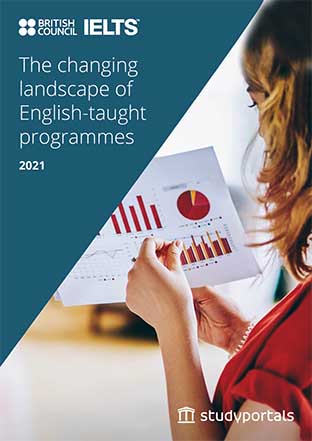The global overview, The Changing Landscape of English-Taught Programmes, published by the British Council and comparison study choice platform Studyportals, identified 27,874 full masters and bachelor degree programmes taught in English outside the big four English-speaking study destination nations.
Until recently the main competition for English-taught programmes (ETPs) came from European higher education institutions in countries such as the Netherlands, Sweden and Denmark as well as from smaller English-speaking countries like Ireland and New Zealand.
But trends since January 2017 reveal it is the Chinese and Sub-Saharan African regions that have seen the fastest percentage growth rate of ETPs, doubling their provision in the last five years.
Edwin van Rest, founder and chief executive officer of Studyportals, said: “The number of destination countries is widening and the flow of students across the world is now spread more evenly across different countries, with more destinations for students to choose from.”
China has strong international education ambitions, developing its higher education system to improve in global rankings, provide scholarships for prospective students, create global partnerships and recruit internationally.
Pre-pandemic, it aimed to recruit 500,000 international students by 2020 and reached 492,000 in 2019. A key part of the strategy is increasing English-taught provision and it now accounts for 12% of ETPs outside the big four English-speaking countries.
India has also announced the intention to host 200,000 visiting students by 2023.
These signals are pointing to a shift in Asia-Pacific countries transitioning from ‘sending’ markets to ‘receiving’ markets for international students.
The report mapped 157,278 bachelor and masters degree programmes worldwide taught in English. While it found that 81.7% were offered by the big four Anglophone destinations, it showed that almost one in five ETPs are offered outside the major players.
In 2021, Studyportals identified 27,874 programmes outside the ‘big four’. This represents a growth of 77% compared to 2017.
Of the 27,874 ETP programmes outside the big four, the vast majority are currently offered within the European Higher Education Area, which accounts for 63% of provision, followed by the Chinese region at 12.2%, Sub-Saharan Africa at 8.1% and East Asia at 6.7%.
The Middle East and North Africa, South Asia and Americas regions offer a relatively lower number of ETPs, at 4.7%, 3.6% and 1.8% respectively, according to the report.
More:
https://www.universityworldnews.com/post.php?story=20211207110915532

